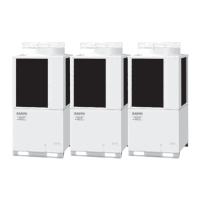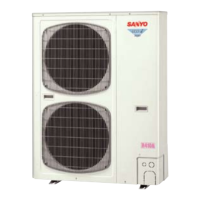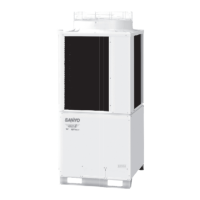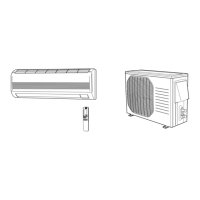Do you have a question about the Sanyo C0971 and is the answer not in the manual?
Crucial steps for safe operation and adherence to standards.
Explanation of hazard symbols for severe injury/death or property damage.
Safety guidelines for electrical wiring, emphasizing qualified electricians.
Guidance on safe handling, lifting, and installation practices.
Precautions for connecting tubing and performing maintenance.
Warnings about ventilation and refrigerant gas hazards.
Outdoor and indoor air intake temperature limits for cooling operation.
Detailed specs including performance and electrical ratings.
Detailed specs including performance and electrical ratings.
Detailed specs including performance and electrical ratings.
Detailed specs including performance and electrical ratings.
Details on Control PCB, Fan Motor, Flap Motor, and Heat Exchanger Coil.
Details on Control PCB, Fan Motor, Flap Motor, and Heat Exchanger Coil.
Details on Control PCB, Compressor, Fan Motor, and Heat Exchanger Coil.
Details on Control PCB, Compressor, Fan Motor, and Heat Exchanger Coil.
Details on Control PCB, Compressor, Fan Motor, and Heat Exchanger Coil.
Details on Control PCB, Compressor, Fan Motor, and Heat Exchanger Coil.
Graphs showing resistance of various sensors at different temperatures.
Technical drawings showing size and measurements of the indoor unit.
Technical drawings showing size and measurements of the outdoor unit.
Diagram of refrigerant path and importance of insulating tubing.
Charts showing low pressure, operating current, and discharge temp. vs. outdoor temp.
Charts showing low pressure, operating current, and discharge temp. vs. outdoor temp.
Charts showing low pressure, operating current, and discharge temp. vs. outdoor temp.
Charts showing low pressure, operating current, and discharge temp. vs. outdoor temp.
Graph showing air velocity and distance for different flap angles.
Graph showing air velocity and distance for different flap angles.
Running amps and power input for various configurations.
Running amps and power input for various configurations.
Schematic showing electrical connections for the indoor unit.
Schematic showing electrical connections for the outdoor unit.
Schematic showing electrical connections for the outdoor unit.
Guidelines for choosing a safe and effective location for the indoor unit.
Guidelines for selecting the best location for the outdoor unit.
Recommendation for using baffle plates on specific outdoor models.
Guidance on selecting appropriate wire size and length for wiring.
Recommended locations and methods for mounting the remote control.
Step-by-step procedure for testing the air conditioner after installation.
Instructions for removing and reattaching the indoor unit's front grille.
Procedure to set addresses to prevent remote signal interference.
Instructions for safely disconnecting and connecting electrical connectors.
Details on emergency operation, SENSOR DRY modes (A, B), and monitoring.
Explains HIGH POWER, NIGHT SETBACK, lamp indicators, and timer backup.
Details on freeze prevention, compressor temp. control, and current cut-off features.
Safety steps before troubleshooting and how to perform self-diagnostics.
Guide to understanding indoor unit lamp indicators for fault diagnosis.
Steps to take if the self-diagnostics function does not work.
Procedures to check unit operation and serial communications.
Steps to diagnose issues with the outdoor fan motor.
Explains noise problems and electromagnetic interference, with solutions.
Procedures for measuring insulation resistance of power cord and unit components.
Method for checking fuse continuity using a multimeter.
Details on R410A composition, properties, and handling.
Pre-service checks, flare tool specs, and tubing handling for R410A.
List of specialized tools needed for R410A refrigerant systems.
Steps for diagnosing compressor issues and replacing it.
Guidelines for recharging refrigerant, including cylinder configurations.
Steps to detect, repair, and recharge refrigerant after a leak.
Guidance on adding refrigerant and adapting older systems.
Description of main features like remote control, timers, and filters.
Advice on choosing the proper location for the unit, considering safety and performance.
Requirements for wiring, grounding, and consulting electricians.
Important safety warnings for operating and using the air conditioner.
Identification and function of key parts like air intakes, outlets, and tubes.
Explanation of display lamps and the remote control receiver function.
Glossary of symbols shown on the remote control display.
Detailed explanation of each button on the remote control.
Explanation of temperature, mode, fan speed, and special function buttons.
Instructions for sensor, display, time settings, address switch, and battery replacement.
How to operate the unit with the remote and recommended installation spots.
Step-by-step guide for basic operation modes like Dry, Cool, and Fan.
How to adjust fan speed automatically or manually and operate in fan-only mode.
Explanation of the Night Setback feature for energy efficiency.
Details on QUIET, HIGH POWER, and ION modes for operation.
Special operational notes for DRY, Cooling, power failure, clicking sounds, and remote signals.
Step-by-step guide to set the current time and the OFF timer.
Instructions for setting ON timer, repeat timers, and canceling timer programs.
How to use the 1-hour OFF timer and tips for saving energy.
Instructions for adjusting horizontal and vertical airflow, including sweep and auto flap.
How to operate the unit manually and clean the casing/grille.
Steps for removing, cleaning, and replacing the anti-mold filter.
Instructions for installing, cleaning air filters, and cleaning the ion generator.
Table listing common problems, their causes, and recommended remedies.
Specifies indoor and outdoor temperature ranges for cooling operation.
Crucial steps for safe operation and adherence to standards.
Explanation of hazard symbols for severe injury/death or property damage.
Safety guidelines for electrical wiring, emphasizing qualified electricians.
Guidance on safe handling, lifting, and installation practices.
Precautions for connecting tubing and performing maintenance.
Warnings about ventilation and refrigerant gas hazards.
Outdoor and indoor air intake temperature limits for cooling operation.
Detailed specs including performance and electrical ratings.
Detailed specs including performance and electrical ratings.
Detailed specs including performance and electrical ratings.
Detailed specs including performance and electrical ratings.
Details on Control PCB, Fan Motor, Flap Motor, and Heat Exchanger Coil.
Details on Control PCB, Fan Motor, Flap Motor, and Heat Exchanger Coil.
Details on Control PCB, Compressor, Fan Motor, and Heat Exchanger Coil.
Details on Control PCB, Compressor, Fan Motor, and Heat Exchanger Coil.
Details on Control PCB, Compressor, Fan Motor, and Heat Exchanger Coil.
Details on Control PCB, Compressor, Fan Motor, and Heat Exchanger Coil.
Graphs showing resistance of various sensors at different temperatures.
Technical drawings showing size and measurements of the indoor unit.
Technical drawings showing size and measurements of the outdoor unit.
Diagram of refrigerant path and importance of insulating tubing.
Charts showing low pressure, operating current, and discharge temp. vs. outdoor temp.
Charts showing low pressure, operating current, and discharge temp. vs. outdoor temp.
Charts showing low pressure, operating current, and discharge temp. vs. outdoor temp.
Charts showing low pressure, operating current, and discharge temp. vs. outdoor temp.
Graph showing air velocity and distance for different flap angles.
Graph showing air velocity and distance for different flap angles.
Running amps and power input for various configurations.
Running amps and power input for various configurations.
Schematic showing electrical connections for the indoor unit.
Schematic showing electrical connections for the outdoor unit.
Schematic showing electrical connections for the outdoor unit.
Guidelines for choosing a safe and effective location for the indoor unit.
Guidelines for selecting the best location for the outdoor unit.
Recommendation for using baffle plates on specific outdoor models.
Guidance on selecting appropriate wire size and length for wiring.
Recommended locations and methods for mounting the remote control.
Step-by-step procedure for testing the air conditioner after installation.
Instructions for removing and reattaching the indoor unit's front grille.
Procedure to set addresses to prevent remote signal interference.
Instructions for safely disconnecting and connecting electrical connectors.
Details on emergency operation, SENSOR DRY modes (A, B), and monitoring.
Explains HIGH POWER, NIGHT SETBACK, lamp indicators, and timer backup.
Details on freeze prevention, compressor temp. control, and current cut-off features.
Safety steps before troubleshooting and how to perform self-diagnostics.
Guide to understanding indoor unit lamp indicators for fault diagnosis.
Steps to take if the self-diagnostics function does not work.
Procedures to check unit operation and serial communications.
Steps to diagnose issues with the outdoor fan motor.
Explains noise problems and electromagnetic interference, with solutions.
Procedures for measuring insulation resistance of power cord and unit components.
Method for checking fuse continuity using a multimeter.
Details on R410A composition, properties, and handling.
Pre-service checks, flare tool specs, and tubing handling for R410A.
List of specialized tools needed for R410A refrigerant systems.
Steps for diagnosing compressor issues and replacing it.
Guidelines for recharging refrigerant, including cylinder configurations.
Steps to detect, repair, and recharge refrigerant after a leak.
Guidance on adding refrigerant and adapting older systems.
Description of main features like remote control, timers, and filters.
Advice on choosing the proper location for the unit, considering safety and performance.
Requirements for wiring, grounding, and consulting electricians.
Important safety warnings for operating and using the air conditioner.
Identification and function of key parts like air intakes, outlets, and tubes.
Explanation of display lamps and the remote control receiver function.
Glossary of symbols shown on the remote control display.
Detailed explanation of each button on the remote control.
Explanation of temperature, mode, fan speed, and special function buttons.
Instructions for sensor, display, time settings, address switch, and battery replacement.
How to operate the unit with the remote and recommended installation spots.
Step-by-step guide for basic operation modes like Dry, Cool, and Fan.
How to adjust fan speed automatically or manually and operate in fan-only mode.
Explanation of the Night Setback feature for energy efficiency.
Details on QUIET, HIGH POWER, and ION modes for operation.
Special operational notes for DRY, Cooling, power failure, clicking sounds, and remote signals.
Step-by-step guide to set the current time and the OFF timer.
Instructions for setting ON timer, repeat timers, and canceling timer programs.
How to use the 1-hour OFF timer and tips for saving energy.
Instructions for adjusting horizontal and vertical airflow, including sweep and auto flap.
How to operate the unit manually and clean the casing/grille.
Steps for removing, cleaning, and replacing the anti-mold filter.
Instructions for installing, cleaning air filters, and cleaning the ion generator.
Table listing common problems, their causes, and recommended remedies.
Specifies indoor and outdoor temperature ranges for cooling operation.
| Brand | Sanyo |
|---|---|
| Model | C0971 |
| Category | Air Conditioner |
| Language | English |












